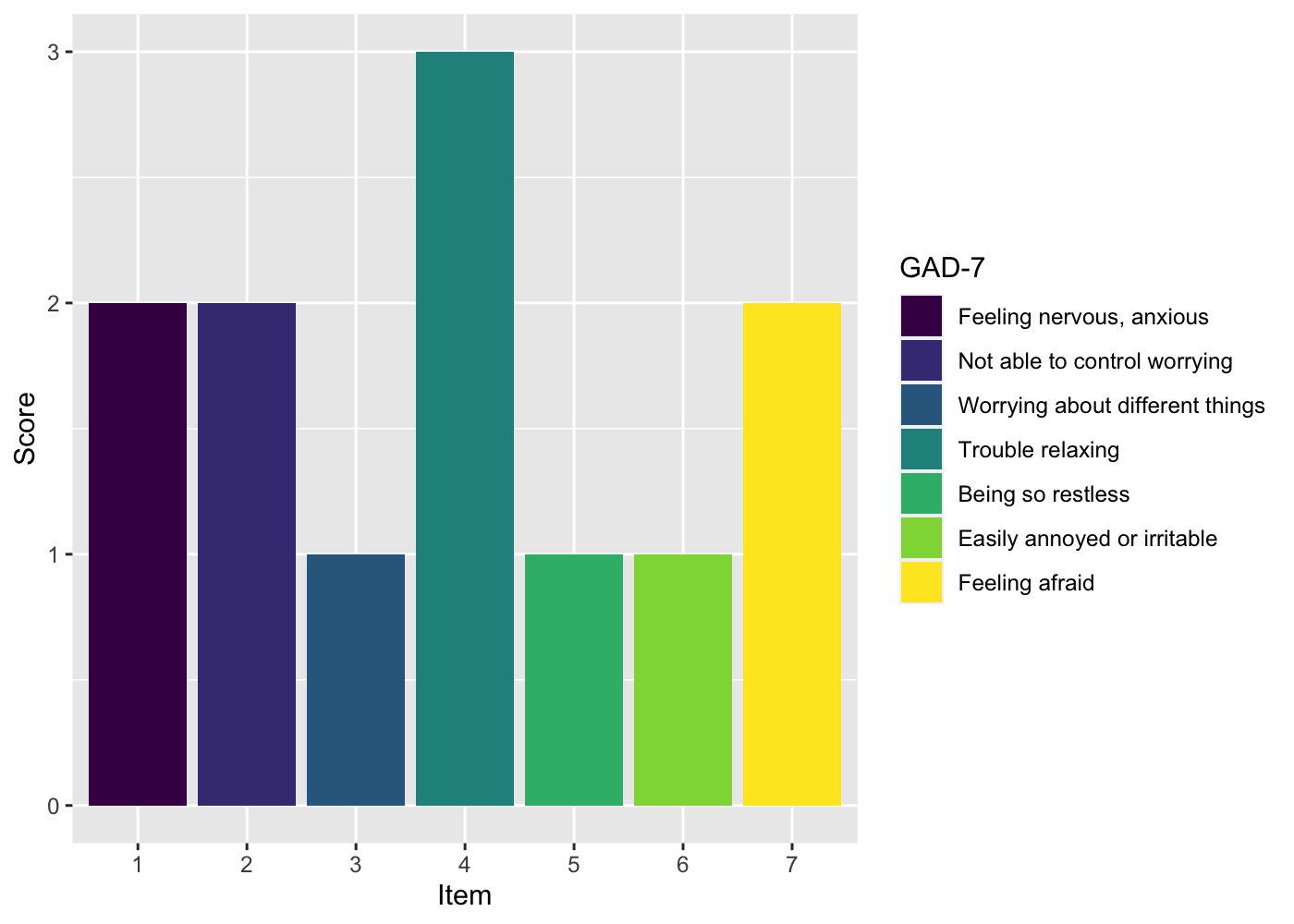The goal is to provide a catalogue of questionnaire details (e.g item labels, response categories, references, and more) to speed up the analysis and reporting of results.
- Questionnaire data
- Item labels (short/long)
- Information about measurement, e.g. internal consistentcy, test-retest reliability
- Information about interpretation, e.g. clinical cutoffs, reliable change index
- Information about availability
- Citations
- Helper functions for working with questionnaire data
- Check item/sum range
- Reproducible data correction
- Calculate prorated sums/means
You can install the development version from GitHub with:
# install.packages("devtools")
devtools::install_github("milanwiedemann/questionnaires")- Patient Health Questionnaire 9-item scale (PHQ-9; Kroenke, Spitzer, & Williams, 2001)
- Generalized Anxiety Disorder 7-item scale (GAD-7; Spitzer, Kroenke, Williams, & Löwe, 2006)
This example illustrates how item labels from this package can be used in ggplot2 figures.
# Load packages
library(ggplot2)
library(tibble)
library(questionnaires)
set.seed(1234)
# Create some data
df <- tibble(item = 1:7,
score = sample(1:3, 7, replace = T))
# Create figure using short labels from gad7
ggplot(df, aes(x = factor(item), y = score, fill = factor(item))) +
geom_bar(stat="identity") +
ggplot2::scale_fill_viridis_d(labels = gad7$item_label_short) +
labs(x = "Item", y = "Score", fill = gad7$measure_short)This is a basic example which shows how to create a table with long label descriptions of the PHQ-9:
# Load packages ----
library(questionnaires) # For questionnaire data
library(dplyr) # For data manipulation
library(knitr) # For creating tables
phq9 %>%
select(item_number, item_label_long) %>%
kable(col.names = c("Item", "Description"))| Item | Description |
|---|---|
| 1 | Little interest or pleasure in doing things |
| 2 | Feeling down, depressed, or hopeless |
| 3 | Trouble falling or staying asleep, or sleeping too much |
| 4 | Feeling tired or having little energy |
| 5 | Poor appetite or overeating |
| 6 | Feeling bad about yourself — or that you are a failure or have let yourself or your family down |
| 7 | Trouble concentrating on things, such as reading the newspaper or watching television |
| 8 | Moving or speaking so slowly that other people could have noticed? Or the opposite — being so fidgety or restless that you have been moving around a lot more than usual |
| 9 | Thoughts that you would be better off dead or of hurting yourself in some way |
When writing in RMardown it’s easy to reference item labels in text using the following:
Most clients showed most improvement on item 1 of the GAD-7 ('`r questionnaires::gad7[[1, "item_label_long"]]`')Most clients showed most improvement on item 1 of the GAD-7 (‘Feeling nervous, anxious or on edge’)
A new questionnaire can be added to this library by creating a dataset
with all information in the
create-measures.R in the data-raw
folder of this repositoty. Details for a new dataset needs to be added
to data.R file in the data folder of this repositoty.
- Which licence would be appropriate for a data package like this?
- maybe there should be a function to call the questionnaire e.g. get_questions("gad7", labels = "short", name = "short") and get_reponses("gad7", values = TRUE, wordings = TRUE). the functions would take the info from the underlying data sets
- What are the legal challanges with copyright, license fees … and does it even matter for a project like this?
- Would it be possible to just have short item labels for questionnaires that are not free to use?
- Which information about a measure should be available in the help files, e.g. internal consistentcy, test-retest reliability, cutoffs, … ?
- How to best name data sets so it doesn’t get confusing, e.g.
gad7vsgeneral_health_anxiety_questionnaire_7item? - What’s a good package name, e.g.
measureme,measureR,measuResvsquestionnaires? - What’s the best data structure to store this information, especially when questionnaires are not straightforward, e.g. different repsonse categories for each item?
- How could different languages of the same questionnaire be
integrated, e.g. suffix
_enfor English,_defor German? - This could also be integrated in a shiny app or similar, e.g. for data entry from paper/pencil or data collection?
- add my functions to check the item & sum/mean range?
- add my functions to calculate prorated mean?
